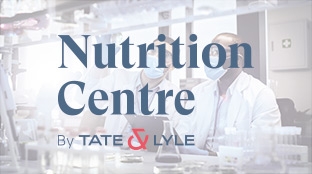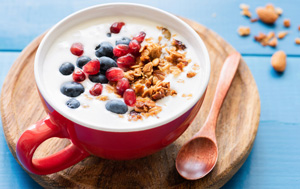Making a food or drink that is plant-based is a way of making it healthier but, importantly, plant-based foods are not more nutritious than those containing animal-derived ingredients by default. That is determined by the salt, sugar, fat, calorie and micronutrient content.
What can be done to enable plant-based food and drink to not only look and taste like their traditional counterpart but to also be as or more nutritious?
This article was written by Kavita Karnik, Global Head of Nutrition and Regulatory Affairs, and featured in Tate & Lyle’s digital report Protecting Planet and People through Ingredient Innovation published in Sustainability Magazine.
Understanding different purchase drivers
When the term ‘flexitarian’ was first coined in the 1990s, the focus was on enabling consumers to access the purported health benefits of a vegetarian diet without cutting out favourite foods entirely. That trend has increased in recent years, especially around the pandemic, with people viewing diet as a controllable modifier of health, in parallel with growing awareness of climate change and our diet’s contribution.
Today, ‘plant-based’ can mean two different things: 1. Food and drink made exclusively from fruits, vegetables, legumes, wholegrains, nuts and seeds, such as fruit smoothies, nut butters, and bean burgers. 2. Food and drink designed to mimic animal-based products, such as milk alternatives, vegan cream cheese, and imitation meat burgers.
When developing plant-based products, understanding the consumer drivers is key. The perceived impact on health is an important one. Manufacturers are keen to develop nutritious plant-based products, even when the product is formulated to cater to other drivers, such as growing concern around climate change. With the right nutrition and formulation know-how during development, solutions that support healthy living can be found.
Plant-based mayonnaise - Khai qi NG, Category Development and Planning Manager, Asia Pacific
We have significant experience in plant-based mayonnaises. Traditional mayo is made by emulsifying eggs, oil and an acid such as lemon juice to create a rich texture. Removing egg means we must replicate that emulsion using vegetable oil and functional plant-based proteins. In a recent prototype, we achieved this with a solution using one of our texturants and complementary plant-proteins to help increase viscosity by ensuring the oil drops are distributed in the mix and remain stable, achieving a balanced product with luxurious mouthfeel. We also reduced the fat content from 65%, typical in traditional mayos, to 40%, retaining its squeezability, soft gel appearance and shape.
Pushing nutrition up the priority list
People following flexitarian, vegetarian or vegan diets tend to pay greater attention to the ingredients in the products they buy than the average consumer, which is one of the motivators for producers aiming to incorporate recognisable ingredients. For consumers, these choices don’t always represent a healthier choice. Coconut-derived ingredients, for instance, have a “health halo” but are typically higher in saturated fat than their animal-based counterparts, even cream. Involving nutrition experts in the formulation of products is crucial to ensuring the final food or drink provides benefits beyond superficial label attributes.
Plant-based desserts – Stephanie DuPuy, European Technical Services Director
Coconut-derived ingredients are popular in the plant-based dessert category as they can replicate many of milk’s functionalities in a recipe and consumers have a positive association. To help customers develop healthier, next-generation dairy dessert alternatives, our global food scientists have been helping them switch to healthier recipes, such as desserts reduced in saturated fats, while matching the desirable textural attributes consumers look for with an improved nutrition label.
Taking steps to match nutrition
Understanding the nutritional roles that animal protein plays in a recipe is the starting point in finding its replacement. For instance, milk protein, like whey, is of very high quality, which is one of the reasons why most national health agencies still advocate its role in a healthy, balanced diet. When product developers and marketeers work with nutritionists to understand the intended consumer and their health goals, they can better account for their needs and preferences in the final formulation. Considerations such as the digestibility of plant-based protein and amino acid composition will be important for foods intended for children or older adults. Helpfully, the range and availability of protein alternatives – soy, grain, vegetable/ plant or single-cell (fungi or algae)-based - has improved significantly in recent years.
Meat alternatives– Olaf Kohnke, Senior Technical Service Manager Soups, Sauces and Dressings, Europe
A current challenge for sausage alternative producers is protein delivery. With leading academics, we’ve developed a proprietary calculation method to help producers of all types of foods and drinks to create recipes with protein and essential amino acids quality comparable to animal-derived foods, without needing excessive protein levels which bring extra calories for consumers and costs for producers, as well as impacting mouthfeel.
Finding opportunities to boost nutrition
For the plant-based sector, we have an opportunity to introduce nutritional benefits consumers wouldn’t usually find in traditional products, and which the target audience would welcome. Plant-based ingredients can also contain bioactive materials in higher quantities than animal-derived equivalents, such as flavonoids, phenolic acids, and saponins, which emerging science is showing can have anti-inflammatory and other beneficial properties.
Plant-based confectionery – Sanjiv Avashia, Principal Scientist, North America
We’ve worked extensively with customers on low-sugar plant-based gummy sweets, using pectin instead of gelatine. Our most successful recipe combines our low-calorie rare sugar allulose with one of our plant-based stevia sweeteners to provide excellent sweetness and flavour release. Incorporating our fibre, we’ve been able to offer additional nutrition, enabling consumers to have 50% of their recommended daily allowance of fibre per 30g serving.
Tate & Lyle’s nutrition and formulation experts are here to help future-focused brands grasp the opportunity to create new products for a healthier population and a healthy planet.

Nutrition plays a key role in consumers’ lives
We address the health and nutritional needs of your consumers using our science-based innovative ingredient solutions. Discover how in our Nutrition Centre...




